

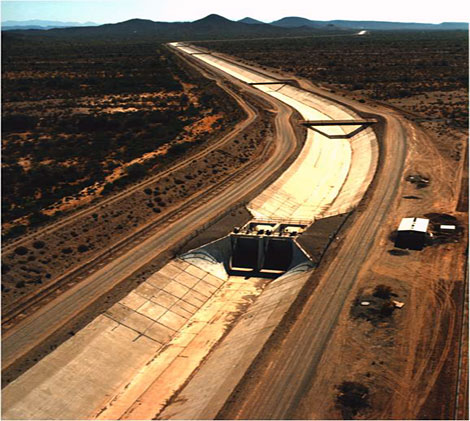 Central Arizona Project canal. (Reclamation photograph)
Central Arizona Project canal. (Reclamation photograph)During the 1980s, construction on the Central Arizona Project aqueduct continued. In this decade, the CAP would bring Colorado River Water to central Arizona for the first time. Construction began in 1973, but it was not until May 22, 1985, that the first water deliveries occurred, and it would be almost another ten years before the project was declared "substantially complete." With the initial delivery of 50 cubic feet per second to the Harquahala Valley Irrigation District, located about sixty miles west of Phoenix, a new era of water use and sustainability began in Arizona (see article on Water Uses). Farmers who had been using groundwater to irrigate their crops, began applying Colorado River water to their cotton, lettuce, pistachios, melons and more.
CAP water reached the Phoenix metropolitan area in November of that year when two six-foot flood gates were opened, allowing Colorado River water to be delivered to the Union Hills Water Treatment plant and the residents of Phoenix, Arizona.
CAP controversy continues through construction phase
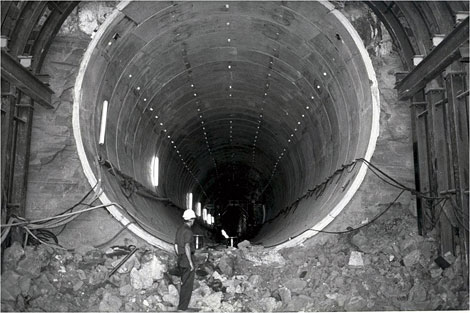 CAP tunnel through Bucksin Mountain at the Lake Havasu intake channel. The tunnel is 22-feet in diameter and 7 miles long. (Reclamation photograph)
CAP tunnel through Bucksin Mountain at the Lake Havasu intake channel. The tunnel is 22-feet in diameter and 7 miles long. (Reclamation photograph)Even as construction progressed, elements of the project remained controversial. Several dams that had been included in the original authorization were later eliminated. The Colorado River Basin Act, Public Law 90-537, which was passed in 1968 and authorized construction of the Central Arizona Project, contained language that allowed two proposed dams to be replaced by "suitable alternatives." The two dams, Orme and Hooker Dams, would have been built on the Verde River to provide additional storage that would be allocated to CAP water users
The Central Arizona Water Control Study, initiated in 1978 to study alternatives to Orme Dam, looked for ways to replace its authorized functions of water storage and flood control on the Salt and Verde Rivers.
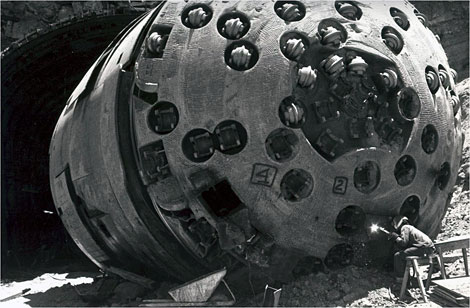 Tunnel boring machine used in the construction of the Central Arizona Project. (Reclamation photograph)
Tunnel boring machine used in the construction of the Central Arizona Project. (Reclamation photograph)For three years, Reclamation conducted investigations and developed several alternative plans. Finally, Reclamation and the Arizona Governor's Advisory Committee agreed upon an alternative known as Plan 6. This plan called for the construction of New Waddell Dam on the Agua Fria River; Cliff Dam on the Verde River (see Environment article); a new or enlarged Roosevelt Dam and a reconstructed Stewart Mountain Dam on the Gila River. On November 6, 1981, Secretary of the Interior James Watt announced Plan 6 as the proposed action for the Central Arizona Water Control Study, contingent upon a completion of an Environmental Impact Statement (EIS) on all the proposed features.
Roosevelt Dam modifications begin
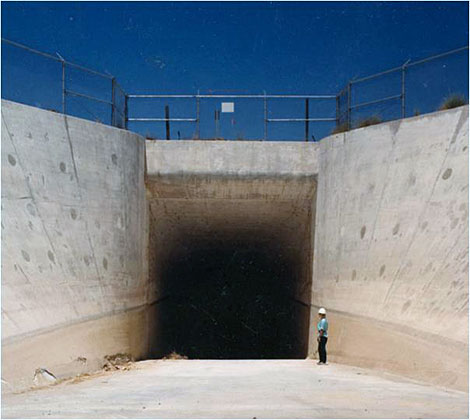 Agua Fria siphon inlet on the Central Arizona Project aqueduct. (Reclamation photograph)
Agua Fria siphon inlet on the Central Arizona Project aqueduct. (Reclamation photograph)Roosevelt Dam had been built on the Salt River in 1911 as part of Reclamation's Salt River Project. However, by the 1980s engineers had determined that the probably maximum flood (the largest conceivable flood) was far greater than previously projected. A "probable maximum flood" would bring more water into the reservoir than the original dam was designed to safely release. In addition, the original dam did not meet the standards for a "maximum credible earthquake." In 1984, the Secretary of the Interior approved modification of Roosevelt Dam under Reclamation's Safety of Dams Program and through CAP authorization under Plan 6, and construction began in 1986.
Work on the historic dam included raising the existing dam by 76 feet, building a top-seal radial-gated spillway on each abutment, and construction of a lake-tap river outlet works/power penstock through the left abutment. Dam modification was designed as a single-curvature, uniform thickness, mass concrete arch dam covering the original stone masonry of the dam. The top-seated radial spillways and river outlet works were designed to regulate flood releases, normal releases, and reservoir evacuation. Modification of Roosevelt Dam as specified under the CAP's Plan 6 was completed in 1996.
Computers control water deliveries
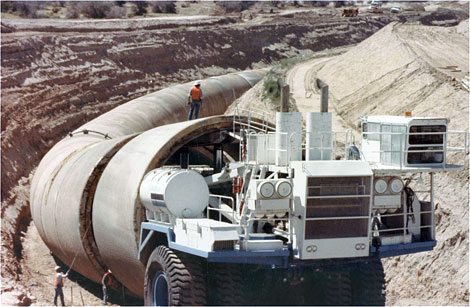 Machine used to move pipe sections which were cast on site and then moved to the crane to be placed in the excavation. Pipe sections were 21-feet inside diameter, 22-feet long, and weighed 225 tons each. (Reclamation photograph)
Machine used to move pipe sections which were cast on site and then moved to the crane to be placed in the excavation. Pipe sections were 21-feet inside diameter, 22-feet long, and weighed 225 tons each. (Reclamation photograph)While construction of the delivery system features of the CAP commenced in the 1970s, creation of the project's computerized operating system did not begin until the 1980s. The reason for the delay in development resulted from Reclamation's decision to wait for technological advances. In preparation for creation of the operating system, Reclamation officials toured and investigated aqueduct systems similar to the CAP's in California, Spain, and France where computerized systems regulated the water projects. After viewing contemporary systems, Reclamation began designing software for the CAP's computerized control system. Software design allowed for upgrading the system as technology advanced. Development of the Programmable Master Supervisory Control System (PMSC) began in 1982. The PMSC was designed to perform fully automated operations of project aqueducts from a centralized control room located at the project's headquarters in Phoenix. Completed a few years later, PMSC is the backbone of the CAP.
Sources:
http://www.usbr.gov/projects/Project.jsp?proj_Name=Central Arizona Project&pageType=ProjectHistoryPage
http://www.usbr.gov/projects/Project.jsp?proj_Name=Central+Arizona+Project
http://www.usbr.gov/lc/phoenix/projects/capproj.html
